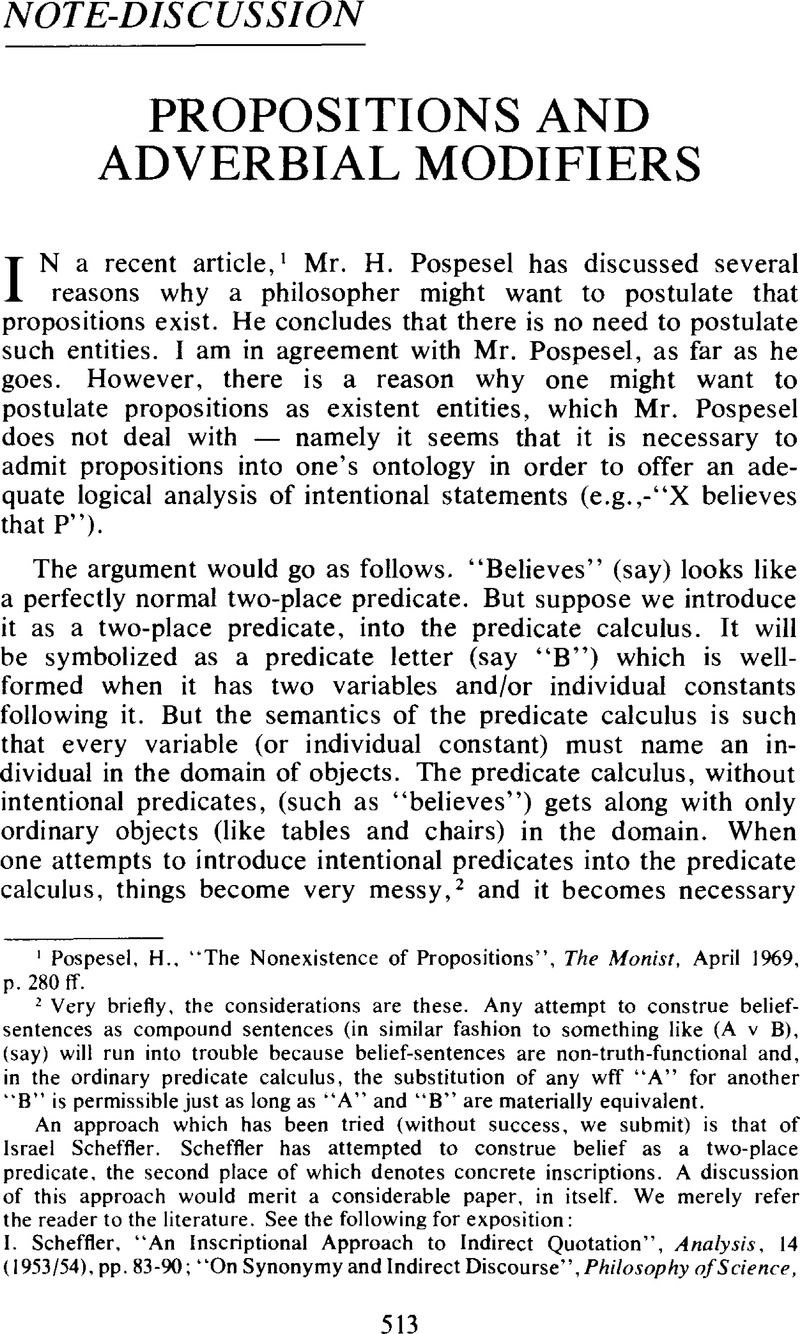No CrossRef data available.
Published online by Cambridge University Press: 05 May 2010

1 Pospesel, H., “The Nonexistence of Propositions”, The Monist, 04 1969, p. 280 ff.Google Scholar
2 Very briefly, the considerations are these. Any attempt to construe beliefsentences as compound sentences (in similar fashion to something like (A v B), (say) will run into trouble because belief-sentences are non-truth-functional and, in the ordinary predicate calculus, the substitution of any wff “A” for another “B” is permissible just as long as “A” and “B” are materially equivalent.
An approach which has been tried (without success, we submit) is that of Israel Scheffler. Scheffler has attempted to construe belief as a two-place predicate, the second place of which denotes concrete inscriptions. A discussion of this approach would merit a considerable paper, in itself. We merely refer the reader to the literature. See the following for exposition:
Scheffler, I., “An Inscriptional Approach to Indirect Quotation”, Analysis, 14 (1953/1954), pp. 83–90CrossRefGoogle Scholar; “On Synonymy and Indirect Discourse”, Philosophy of Science, 1955, p. 39ff; “Inscriptionalism and Indirect Quotation”, Analysis, 1958, p. 12ff; “Prospects of a Modest Empiricism”, Review of Metaphysics, X-XI. 1965: Anatomy of Inquiry, New York, 1963, pp. 98–105.Google Scholar
For critical comments see the following: Church, A., The Problem of Universals, University of Notre Dame Press, 1956Google Scholar; Hempel, Carl, Journal of Symbolic Logic, Vol. 22, No. 2 (1957), p. 208CrossRefGoogle Scholar (a review of “On Synonymy and Indirect Discourse” ); Meckler, Lester, “An Analysis of Belief Sentences”, Philosophy and Phenomenological Research, 1956, p. 318.Google Scholar
3 Noûs, Nov. 1970, p. 311 ff.
4 One way to set up the whole thing — predicate calculus, and Clark's system (including intentional predicates and modifiers) would be the following:
Assuming a standard version of the predicate calculus, make the following additions and changes.
A. Notation
To the predicate calculus, add the following:
1. A denumerable set of intentional verb predicates — B1, B2, …
2. A denumerable set of adverbial modifiers of the following types:
a. Propositional modifiers — Φ1, Φ2…
b. Non-propositional modifiers, ψ1, ψ2…
which will correspond to various types of modifiers such as
i) reference destroying modifiers
ii) reference altering modifiers
iii) negators
iv) others
B. Well-formed Predicates
1. Any single predicate letter ‘Bn’ is an intentional well-formed predicate.
2. Any single predicate letter ‘Fn’ is a non-intentional well-formed predicate.
3. Where ‘B’ is any intentional predicate, and ‘Φ’ is any propositional modifier, then ‘Φ(B)’ is a non-intentional well-formed predicate.
4. Where ‘F’ is any non-intentional predicate, and ‘Φ’ is any non-propositional modifier, then ‘ψ(F)’ is a non-intentional well-formed predicate.
5. Nothing else is a well-formed predicate.
C. Well-formed Formulas
These will be as usual. (If the usual rule reads something like “where ‘P’ is any predicate letter of degree n…(etc.)…” replace it with something of the form “Where ‘P’ is any well-formed predicate expression of degree n, ‘P’ followed by n variables or individual constants is a wff” ).
Valuation would be exactly as Clark has outlined it in the Nous paper cited above. Notice that the setup will not allow something such as “John believes irrationally” to count as well-formed. The machinery could be easily adjusted to allow this as well-formed, if a particular given account of belief required it.
5 It might be argued that since we have now singled out our propositional modifiers as a class distinct unto themselves, the artificiality of the approach is clear; one needs a special class of adverbs simply because “that…” clauses are not genuine adverbs at all.
On the other hand, it can be argued that prepositional adverbs constitute a general class of adverb, which Clark has allowed for (cf. fn. 4, sec. A.2.iv.). After all, they can have almost unlimited content — all possible substitutions for “W” in “[W]”.